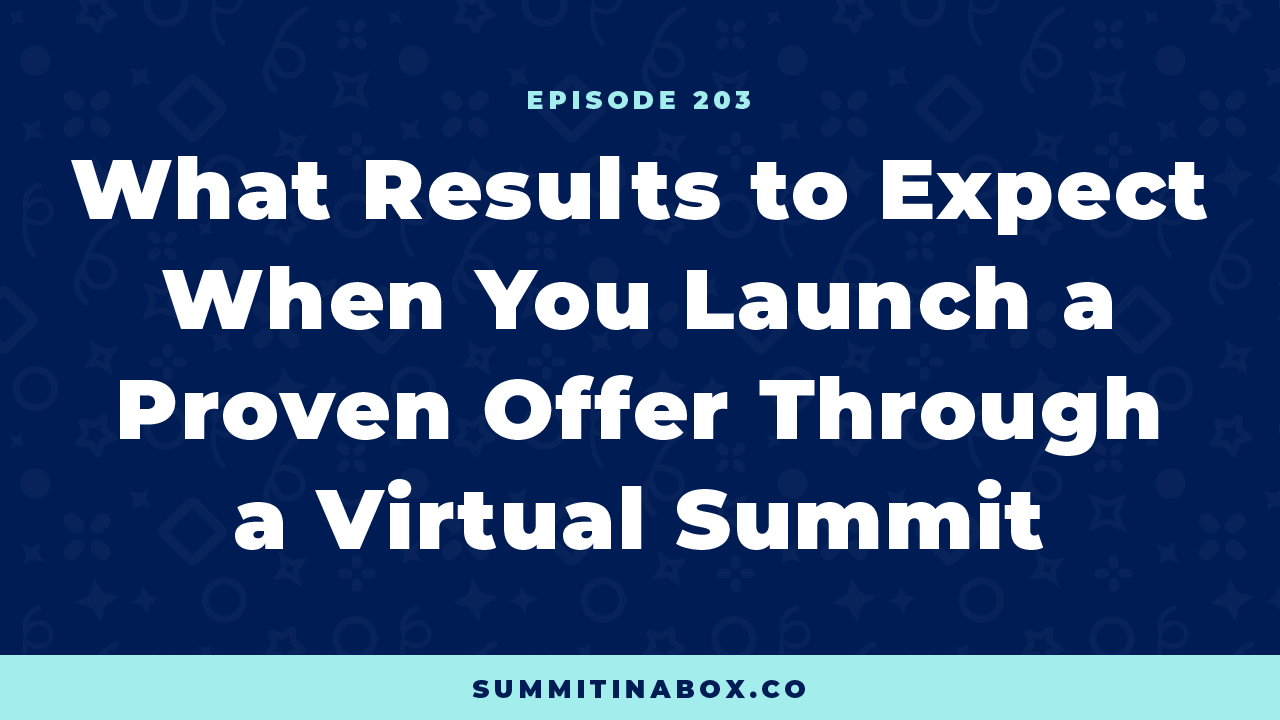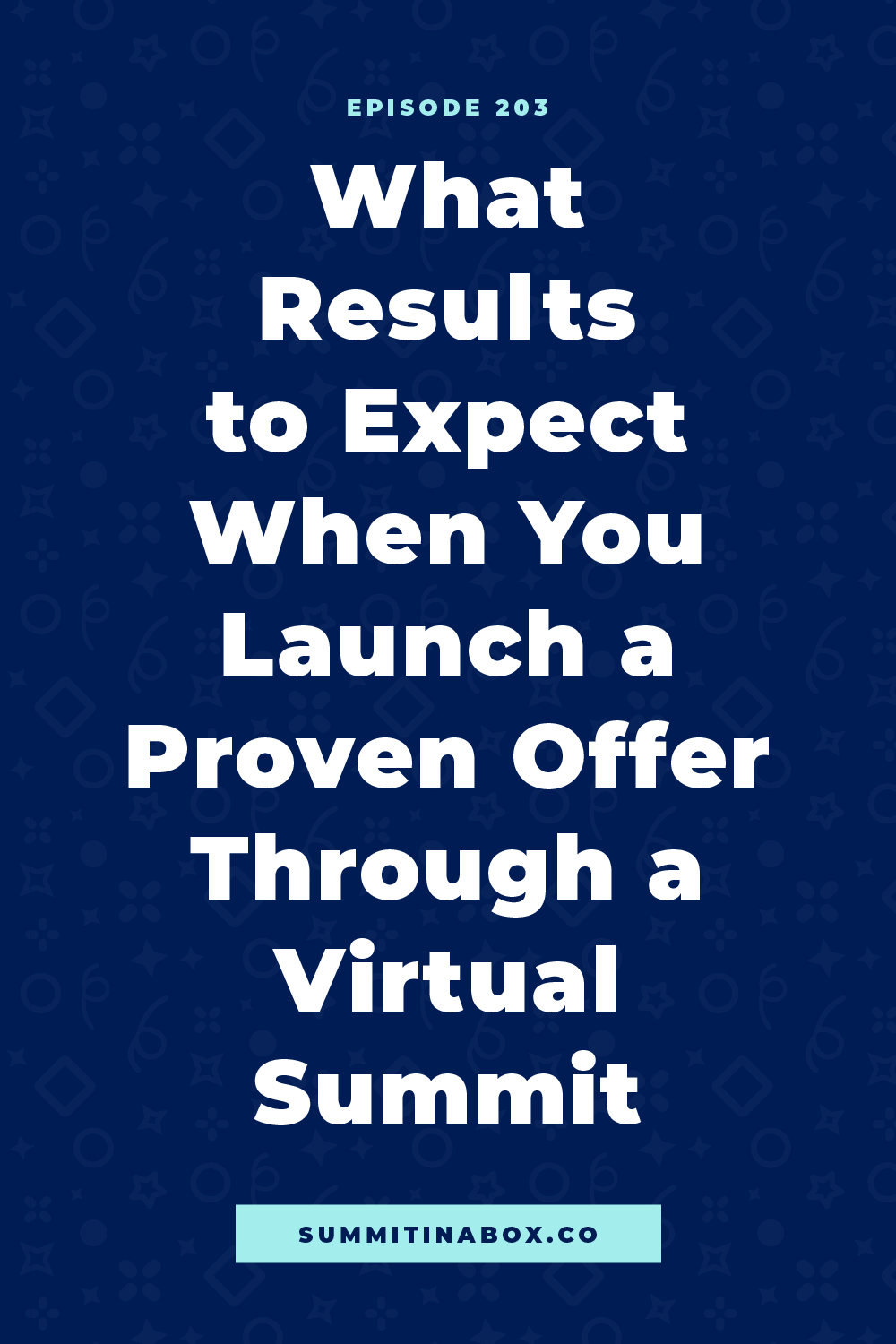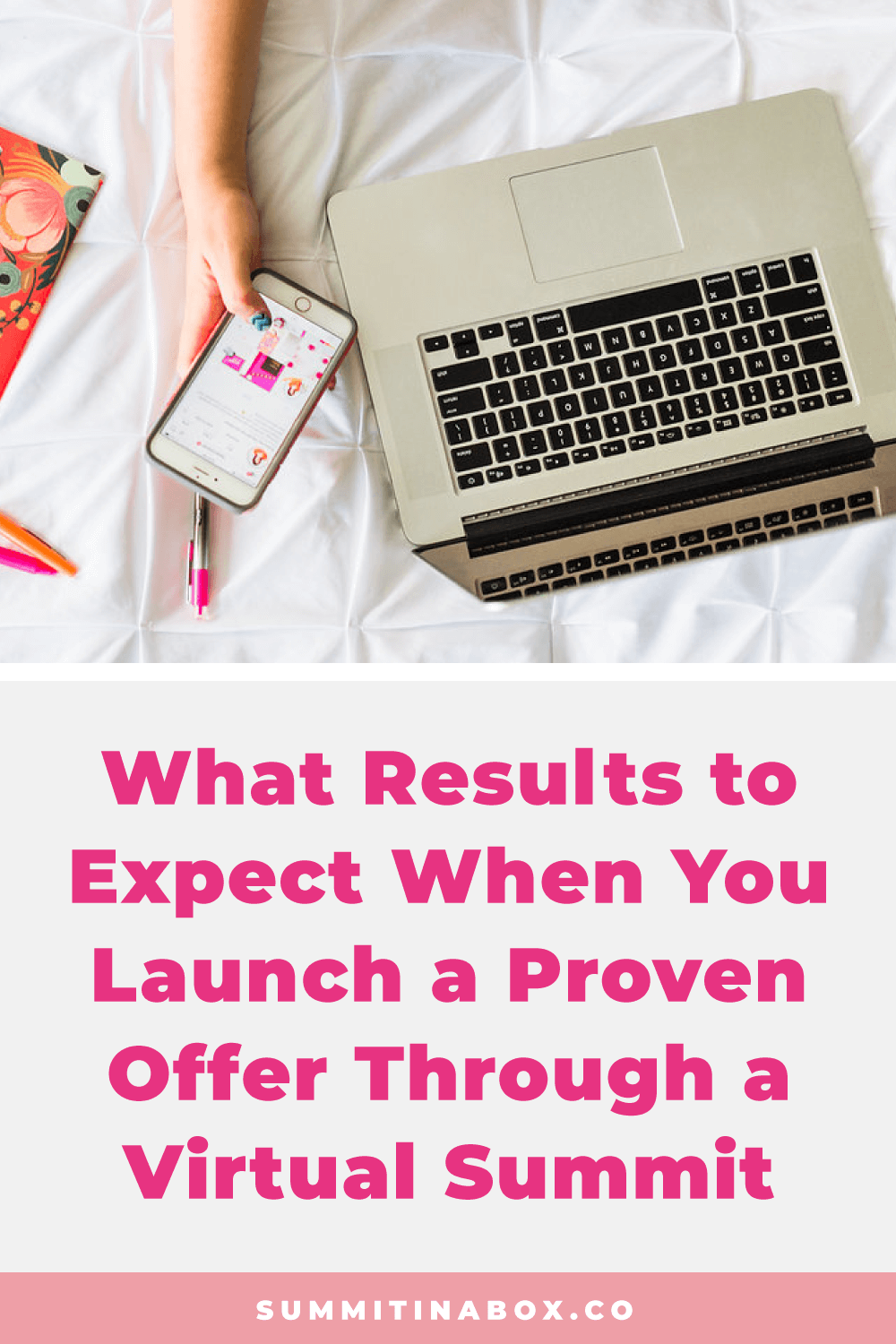What Results to Expect When You Launch a Proven Offer Through a Virtual Summit


Launching through a summit can have incredible benefits for your business, and using the momentum from your summit to launch your course, group program, or other signature offer on the back end is one of them.
I’ve shared previously why it’s so important to launch an offer that is proven following a summit rather than testing out a new offer with a summit. In this episode, we’re talking about what makes launching with a summit different from the experience of launching in other ways.
I often see summit hosts come into the summit hosting process with unrealistic expectations about what results they can expect when launching after their summit, which is totally understandable! Launching with a summit is a unique launch strategy, which means the results you can expect are unique to summits. If you’ve never launched with a summit, how could you know what to expect?
In this episode, I want to set the record straight. Let’s dive in and look at what you can expect when launching with a summit!
Listen to the episode
Download the episode transcript here.
Start with Realistic Expectations
Often when a summit host gets to the end of launching with a summit and is disappointed with their results, it’s because they went in with expectations that were a little too high.
Usually, this is due to choosing a revenue or sales goal that sounds nice, without having an understanding of conversion rates or the numbers they could realistically expect based on their current audience, numbers, and offer price point.
When I work with people to break down what it would take for them to hit their goals with a virtual summit, the two numbers that always start with are:
- Total summit registrations goal
- Course sales goal
A lot of times, when someone shares these two goal numbers with me, I find that the two just don’t quite add up.
For example, someone might say that they want 1500 attendees registered for their summit, and 150 sales of their course. That sounds great on paper, but that's a 10% conversion rate to a cold audience. That's just not how a summit is gonna go.
Summits bring in a significant amount of cold traffic
With a summit, you're attracting a significant amount of cold audience members. There are also going to be a lot of people who sign up for your summit but don't actually engage with the event. This is normal and expected, and we factor this into the goals we set for ourselves and with our clients.
It’s just not realistic to expect that your full list of summit attendees is going to convert the same way as something like a webinar. When someone signs up for a webinar, they are coming in with a lot of interest not just in the topic, but in learning your approach and how you teach it. They usually come into a webinar with an expectation that something is going to be launched, and they’re a warmer audience. That is naturally going to lead to higher conversion rates.
With a summit, not everyone who signs up is necessarily indicating interest in your offer or framework yet. They're interested in your topic for now, and it's your job during the summit and over time to then make them interested in your offer or framework.
Realistic Goals when Launching with a Summit
Overall, you can expect a summit to convert similarly to how you would expect a promotion to your full audience to convert.
If you know that your email list typically converts at about 2% when you launch to your full email list, you can expect your full summit attendee list to convert at a similar rate when launching through a summit.
Part of the power of this strategy is that a summit attracts people at all different stages of the customer journey. Some people come at the very beginning stages and have no idea that they’re even interested in your solution or topic until they see the summit being promoted. These people are signing up to learn about that topic as a whole for the first time, and they're not necessarily ready for what you do yet.
You'll have plenty of opportunities to nurture your new leads and take them to the deeper stages of the customer journey where they’re ready to purchase your offer during the summit and moving forward. But they’re not coming in ready to take the next step.
You'll also attract some people who are aware of your topic and have some interest in it, but they haven’t really taken action on it or started actively looking for a solution to help them in this area.
And your summit will also bring in people who are much further along in the customer journey who are fully aware of how the problem you solve is impacting them and they’re ready for your exact solution.
A summit attracts people at all different stages of the customer journey, which is part of the strength of a summit. You WANT this to happen, because of the long-term benefits beyond immediate revenue from the launch at the end.
Keep the unengaged subscribers in mind when setting goals
With all this in mind, I recommend basing your goals for your launch following a summit based on the conversion rates you see when launching to your full email list,
For me, if I launched my program to my email list, I would expect about a 1.5 - 2% conversion rate, and so that’s the goal I set when I launch with a summit.
That conversion rate comes from a combination of people who sign up for the summit and then don't open another email about it, all the way to people who attend the webinar you host as a part of the summit.
The webinar following your summit is where you’ll see incredible conversion rates that surpass what you’d normally see during a typical launch. For example, the last time I hosted a webinar as a part of a summit it converted at 41%, which is an absolutely incredible result.
But when you factor in that high conversion rate with the least engaged summit registrants who don’t open an email about the event, it typically evens out to about the same conversion rate you’d see from something like an email launch.
Why host a summit if it doesn’t convert higher than a normal launch?
I could talk about the benefits of a summit all day long that go far beyond the direct revenue you generate from your signature offer sales. But specifically, when it comes to launching with a summit, there are 3 major benefits I see that make it totally worth it:
#1: You’re launching to a new audience + re-engaging your existing audience
If I’m going to see the same conversion rates I’d see during a typical email launch, I’d rather have 1000 new people to include in the launch. With a 2% conversion rate, adding 1000 new leads to your list through your summit would result in an additional 20 sales that you wouldn’t have had otherwise.
#2: The people who sign up for your summit will get ready for your offer over time.
If your summit brings in 1000 new leads, and 20 of those leads convert into clients during the event, that still leaves 980 people for you to continue to nurture over time! Your summit attendees will continue to become aware of what you do, the solutions you offer, and the fact that they want those solutions over time after the summit is over. That's 1000s more people who know what you do, and who will purchase when the time is right for them as you continue presenting your offer to them over time. We still have attendees from a summit we hosted over two years ago join our program every single time we launch.
#3: Your speaker connections can turn into additional profitable collaborations
One of the big benefits I see getting overlooked often is the additional revenue you can bring in through future collaborations with your speakers. Hosting a summit starts off your relationship with your speakers strong by giving them an incredible opportunity to benefit, and that often leads to more collaborations in the future. After hosting a summit, you can leverage those relationships for more collaborations like podcast interviews, guest training tours, and JV webinars that bring in additional revenue and leads down the line.
Set realistic expectations and know that it’s just the beginning
To put all of this in perspective, the last time we launched through a summit, we brought in $45,000 in course sales directly from summit attendees immediately after the event. That lines up with the 2% conversion rate I’d expect to see when launching to my email list.
Since then, we’ve brought in at least an additional $160,000 in sales of our signature offers from attendees who signed up for that summit but weren’t ready to sign up right away. That’s not even including the sales that have come from affiliates, JV partnerships, referrals, or brand recognition that came from the summit.
This strategy is powerful, both immediate and long-term.
It’s important to go in with realistic expectations, knowing that the initial results you see are only a fraction of what’s coming.
I hope this clears up what to expect when you're launching through a summit and lets you set goals that you can be excited for both the immediate return that comes from hosting a summit and the additional revenue and other benefits of hosting a summit that will continue to come in the future.
Resources
- Episode 90: Behind the Scenes of My September 2020 Virtual Summit
- Episode 91: Estimate, Analyze, + Improve Your Virtual Summit Conversion Rates
- Episode 190: A Virtual Summit is a Full Funnel - From Lead Generation to Launch!
- Episode 191: Build On Your Speaker Relationships After a Virtual Summit without Burning Out with Amelia Roberts
- Episode 197: "Free Summits Attract Low-Quality Leads and Freebie Seekers"
- Episode 202: Why Your Offer Needs To Be Proven Before Launching With A Summit
- Launch with a Summit Accelerator™
- 6-Figure Summits Workshop Bundle
- Summit Host Hangout Facebook group
Pin it for later!




